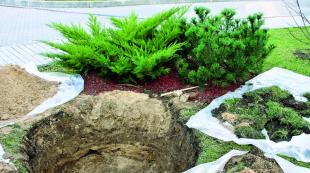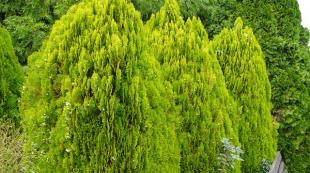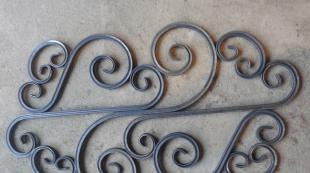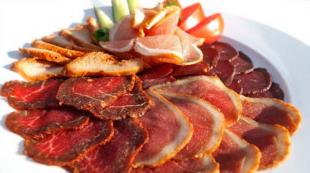Recipe for a paste made from flour and starch. We prepare safe material for children's creativity
Paste has long been used as wallpaper paste. And even with the advent of modern adhesive compositions, many prefer this unpretentious tool. Moreover, the main reason for such a commitment to the paste is not even the cheapness of its preparation.
What is a paste?
First, let's figure out what a paste is. It's glue homemade. With it, paper and wallpaper are easily fixed on almost any surface.
Paste - natural glue of home origin
The paste is prepared from flour or starch with the addition of water and scalded in boiling water. The corn starch paste has the greatest gluing ability. It is followed by homemade glue from wheat flour, in the last place is a paste from potato starch.
Advantages and disadvantages
The fact is that all the most modern adhesive compositions have one big drawback - they do not work well on surfaces covered with old oil paint or primed with drying oil. On such surfaces, only an ordinary paste, cooked from flour or starch, can perfectly cope with its function.
The only drawback of the paste can only be called its instability to moisture. However, this disadvantage can be overcome by using various additives in the preparation of the paste.
The advantages of the paste are many: 
- Properly brewed and filtered, the paste leaves no residue even with not too careful work.
- It adheres well to any surface.
- Its durability is in no way inferior to the most modern adhesive compositions.
- Also, the advantages of the paste include the fact that the wallpaper that is pasted with its use is very easy to remove.
- Water is poured into the container in the amount of 2/3 of the planned volume and boiled.
- Then flour is poured into hot water. This should be done gradually, while thoroughly mixing the solution. Flour will need approximately 1/3 of the volume.
- The solution should be brought to the density of a very liquid dough (cook for 5 minutes).
- After the paste has cooled to 30-40 degrees, it should be filtered through gauze, after which it can be used for its intended purpose.
It is better not to use hot paste. From temperature, the embossed pattern or paint on the wallpaper can be deformed and become unusable.
Method number 2
In this recipe, the ratio of flour and water is 1:3.
Remember that the finished mass should be similar to batter
- Pour the flour into a container. Fill with water.
- We put the container on the stove and cook, stirring constantly, over low heat until the mass becomes homogeneous.
- After the water boils, remove it from the heat, filter through cheesecloth or a sieve, cool.
How to cook from starch with your own hands
The advantage of starch paste over flour paste is its transparency. Although flour paste leaves almost no traces, starch paste is still preferable for pasting walls and light wallpaper.

Damp wall paste has a higher adhesive power
Starch paste recipe for ordinary walls
- 750 g of potato starch are kneaded in 200 ml of wood alcohol.
- To the resulting mass, add 1.5 liters of water, mix thoroughly.
- The next step is to add 8-9 liters of boiling water and bring the whole mixture to a boil.
- Separately from the mixture, 100 g of alum are dissolved in 0.3 l of water.
- The resulting solution is poured into the boiled mixture and mixed until a uniform mass.
- The composition is cooled and filtered.
How to make homemade glue for damp walls
- 40 g of calcium chloride are dissolved in 600 ml of water, the mixture is put on fire and brought to a boil.
- In addition, 400 ml of water and 400 g of potato or corn starch are separately mixed;
- The mixture from the first point is added to the resulting mixture. Stir, heat and add another 4-5 liters of water.
- The resulting mixture is boiled for another 2-3 minutes and removed from heat.
Do not forget to periodically remove the film that forms after the starch paste has cooled.
- Any paste should preferably be used immediately after filtration, or at least on the same day. After a day, the adhesive qualities of the paste are significantly reduced.
- Make the paste in small portions to prevent the mixture from cooling and hardening quickly.
- It is best to store unused mixture in a container with a lid in the refrigerator.
- If the glue gets on the skin or furniture, it is enough to wipe the contaminated area with a damp warm cloth.
- If we talk about additives to the paste, then in addition to PVA glue, you can also use wood glue, which is added in the same quantities as PVA glue (1 part of glue to 1 part of water). At the same time, it should be taken into account that wood glue can leave reddish spots on the wallpaper, and it is not recommended to use such an additive when pasting with very light wallpaper.
A paste with the addition of wood glue is perfect for priming the surface of walls and ceilings before wallpapering. And for these purposes, it should be used hot.
Video: how to cook flour paste for wallpapering, papier-mâché, etc.
10323 0 2
Cooking paste for wallpaper: 3 simple ways+ helpful tips
Forced to interrupt the installation of wallpaper, because the glue has run out, and the stores are already closed? It doesn't matter, I'll tell you how to make a paste for wallpaper from improvised materials, which means that it will be possible to continue the repair.
Paste or ready-made products from the store

Reasons for making a paste:
- Glue ran out. It happens that the repair is delayed until late, the glue is over and the shops are closed. Then you have to look for an alternative to purchased funds;
- Good wallpaper glue is not cheap. For comparison, the same volume of self-prepared products will cost at least half the price;
- There is no universal glue in the store. Therefore, it can be difficult to choose a product suitable for purchased wallpaper. At the same time, there are several simple recipes, using which you can prepare the perfect paste.
- Not all store-bought glue is environmentally friendly.. A do-it-yourself remedy will be made from those components, the safety of which you can personally verify.
What should be the paste

Requirements for self-made pastes:
- Ease of preparation and low price of ingredients;
- Environmental safety due to the absence of toxins and allergens;
- Good adhesion to most prepared substrates;
- Ease of use.
Method 1: Making a starch paste
Method 2: Making a flour paste
| Illustration | Easy flour recipe |
 |
We'll need. To prepare the product, you need a bowl, a sieve, a spoon, a glass of rye flour, finely ground salt, and water.
|
 |
Sifting the flour. Sift a glass of flour through a sieve. This is a mandatory step, as there may be solid inclusions in the flour. |
 |
We mix the solution in cold water. Pour a glass of cold water into the flour and mix the mass until a homogeneous consistency, that is, until all lumps are dissolved. |
 |
Adding salt. Pour a tablespoon of salt into the solution and mix well. I recommend using finely ground salt, as it dissolves faster than coarse salt. |
 |
Mixing hot water. Add 2 cups to the resulting mass hot water and mix. |
 |
Cooking. Pour the resulting mass into a small saucepan. We put the pan on low heat and, stirring constantly, cook for 10 minutes. After that, the flour paste for wallpaper is ready. |
Method 3: Use PVA

PVA in its pure form cannot be used for wallpapering, as it is uneconomical and subsequently such a finish will have to be torn off with pieces of plaster. But PVA can be diluted with water in a 1 to 2 consistency (two parts are water). PVA dissolves cold water to a smooth liquid consistency.
Diluted PVA cannot be stored for a long time. Therefore, we prepare the solution without a stock.
How to enhance the effect of purchased wallpaper paste

The use of glue purchased in building stores does not always guarantee the high quality of the finished result. That is, the wallpaper eventually begins to move away from the walls. What can be done to prevent this from happening?
- First, you need to prepare the solution in strict accordance with the manufacturer's instructions.
- Secondly, try pouring granulated sugar into the prepared solution, at the rate of 1 kg of sugar per 10 liters of the mixture. The result will be amazing, as any wallpaper will stick to reinforced glue.
How to make shop glue
| Illustrations | Cooking instructions |
 |
Mixing the dry mix. We collect cold water in a plastic bucket according to the instructions and begin to mix it. Gradually pour the contents of the package into the water, without stopping to interfere. |
 |
Settling and diluting. After the solution acquires the optimal consistency, let it stand for 10 minutes. If after this period the glue thickens strongly, you can add a small amount of water and place it again. Ready mix should be uniformly plastic, without lumps. |
 |
Closed for storage. If the use of the finished solution is planned for later, close the bucket with a tight lid or, as shown in the photo, tighten it with plastic wrap. |
Answers to frequently asked questions
- How to apply glue? For application on wallpaper and on walls, we use a velor roller and a brush for corners;
- How to apply glue when installing non-woven coatings? When working with non-woven fabric, we only smear the wall, but at the same time we make sure that there are no dry places left;
- What compositions to apply so that there is no mold on the wallpaper? When preparing a paste, bactericidal additives can be mixed into the bulk. But make sure that these additives do not contain chlorine, otherwise the wallpaper will stain;
- What paste to use for pasting on oil paint? Nothing sticks to surfaces painted with oil paints or enamels, therefore, instead of conventional products, I recommend using PVA diluted with water one to one;
- What is the optimum temperature for applying paste? Wallpaper installation is carried out at room temperature. The problem is that the success of the installation depends not only on the air temperature in the room, but also on the temperature of the walls. Therefore, it is better to plan wall decoration with wallpaper on warm time of the year.
Summing up
Now you know how to cook a paste from inexpensive materials that every household probably has. More interesting on the topic can be seen by watching the video in this article. If you have any questions, ask them in the comments.
June 26, 2017If you want to express gratitude, add a clarification or objection, ask the author something - add a comment or say thanks!
To paste over the room with wallpaper without glue is simply unrealistic. You can choose in the store suitable option, but many, knowing how to properly cook paste at home, successfully use it. Why is he good? Why do so many huge selection all kinds of adhesive compositions in the store prefer to make wallpaper glue on their own and how to cook a paste with your own hands? This will be discussed further.
Advantages and disadvantages of using a paste
- The widespread use of paste is due to its low price and availability, because starch or flour can be purchased at any grocery store for a very modest amount of money.
- Glue based on flour or starch, which can be made at home, is suitable for various surfaces. It is considered one of the best for pasting walls previously painted with oil paint or drying oil.
- If the adhesive composition is welded correctly and carefully filtered, it will not leave marks even when the work is done by hand not as neatly as we would like.
- He's got a great grip. In this case, the type of surface does not play any role.
- In terms of durability, it can compete with the highest quality adhesives that you can buy today in hardware stores.
- Removing old wallpaper glued with paste is very simple. You just need to wet the surface. In this case, absolutely no damage will remain on the surface of the wall itself.
- Another important advantage of using a paste is its harmlessness. It can be safely used for pasting a nursery and a bedroom.
Such homemade glue has only one drawback - very low resistance to moisture. However, this can be easily corrected and given the desired properties by adding some substances.
Types of pastes and methods for their preparation
Flour-based glue is the most common DIY option. Its recipe is very simple and anyone can cook it. You will need a galvanized or enameled bucket or any other convenient container, water and, in fact, flour.

Before proceeding with the preparation process itself, it is advisable to calculate the approximate amount of glue that will be needed for pasting.
Consider step by step how to cook flour paste. For this you need:
- pour water into a bucket (2/3 of the planned volume of the finished paste) and bring to a boil;
- add flour (1/3 of the total volume) in small portions and, stirring constantly, cook over low heat until thickened (the density of the mixture should be like dough for pancakes);
- remove from heat and let cool to a temperature of about 40 degrees;
- filter the cooled glue through a sieve or several layers of gauze, which will remove the resulting lumps.
It is very important to prepare the amount of paste that will be needed for work on a given day. It is impossible to store this composition, as it will simply lose the necessary properties.
Do-it-yourself flour paste is suitable not only for wallpapering a room. It can be made and used for paper crafts or for sealing gaps in windows.
It is very important during the preparation of the paste to cool it to the desired temperature, otherwise it can ruin the wallpaper.
For cooking, it is better to take wheat or rye flour. Grinding also matters: the larger, the better the adhesive properties of the composition.
Do not use glue made from rye flour for light-colored materials, as unwanted marks may remain.
Wallpaper glue from starch
A starch-based wallpaper paste is being prepared in the same way as described above. Only here, not flour, but starch is thrown into the water. When the composition has cooled, add a little PVA glue. This will improve its adhesive ability.
Starch-based glue is good when transparency is required, for example, when gluing light paper, pastel-colored wallpaper. But it should be noted right away that its strength is somewhat lower, so it is hardly suitable for heavy wallpaper.
If you have to work with surfaces of dark tones, it is better to replace PVA with wood glue. In this case, the composition will become dark. Do not forget that wood glue on the wallpaper may remain brown spots, so you need to work with glue carefully.
Do-it-yourself starch glue is well suited for pre-walls and walls on which you plan to stick wallpaper. It is important to know that only hot composition should be used as a primer.
Dextrin paste
Potato starch glue or, as it is also called, dextrin paste is used for gluing paper and fabric products.

Recipe. Starch is heated in the oven on a baking sheet at a temperature of 400 degrees until transparent brown lumps form. Then it is cooled to a state of solidification, crushed into powder and diluted with water at the rate of 10 g of powder per 25 ml of liquid. To enhance the adhesive properties of this composition, it is necessary to add 3 grams of sugar to the resulting volume.
- It is advisable to add to any paste during cooking blue vitriol(10 g for each kilogram of starch or flour). Since it contains organic matter, various living creatures can start in it. And copper sulfate previously diluted in warm water will disinfect it. It can also be used as an antiseptic solution of phenol in the amount of 0.02% of the total mass of the adhesive.
- You can prepare a paste both by adding dry substances to water, and vice versa.
- Starch paste is stored only in glassware and no more than 5 hours.
- Any kind of paste must be made and used on the same day. The next day, its adhesive abilities are almost completely lost.
- The density of the glue depends on the material with which you have to work, and therefore the recipe for making glue at home is quite individual.
- Paste recipes based on flour or starch are also suitable for children's creativity. With the help of such compositions, you can create masks and papier-mâché toys with your own hands (in this case, the glue is made thinner).

Conclusion
As you can see, wallpaper paste can be made even at home, and very easily. At the same time, you can significantly save on the purchase of expensive mixtures. You just need to strictly follow the recipe and follow our simple advice and the perfect result will be guaranteed.
Now the market is full of various adhesive products, and earlier they cooked such a mass themselves, and in quality it surpassed many modern analogues. How to make a paste that our grandmothers cooked? There are two proven recipes and several recommendations for choosing ingredients.
What it is
A paste is a do-it-yourself gelatinous adhesive. The composition is used in needlework and less often in repairs (mainly for wallpapering). It does not contain harmful additives, which cannot be said about industrial products. It is thanks to safety that the paste is still relevant. It is a good substitute for PVA.
What is the advantage of making and using a paste for a modern person:
- This is an environmentally friendly product. All stages of preparation are traceable. You can be sure that the composition is safe, unlike what the chemical industry offers.
- The paste replaces expensive adhesives, its cost is very low, in fact, it is equal to the cost of flour or starch.
- Easy to cook, products are available at any time.
- Practical and easy to use formula.
- If you need to remove the wallpaper pasted on the paste, it will not be difficult: just wet the walls, and the coating will come off without leaving a trace.

Of the minuses, it is worth noting the short shelf life. At room temperature, it should be used within a day. If you put it in the refrigerator, it will last there for 2-3 days, but it will still deteriorate, and you will have to throw it away.
To prepare the paste, a minimum of products is used: ordinary wheat / rye flour or starch. To make the composition as convenient as possible for use, you need to adhere to some principles in the choice of components and tools:
- The flour is of low quality. It is this product that gives the adhesive mass the necessary viscosity. Flour premium will not provide the glue with the desired consistency.
- Before use, the flour is sifted through a sieve to get rid of lumps.
- In order for the mass to mix well, you will need a mixer or blender. But it is permissible to stir with a metal spoon - the main thing is that there are no lumps.
- The pan or basin is taken non-stick.
Cooking rules
To prepare a paste, it must be boiled. To do this, a mushy mixture of flour and water is made, placed on the stove and heated over low heat until all the lumps disappear.
Rules for making paste:
- Water is heated on the stove.
- Flour is poured in a thin stream and quickly, to get a more or less uniform consistency, stir.
- The approximate ratio of the bulk component and water is from 1:2 to 1:8.
- The process must be closely monitored so that the mixture does not burn.
- The composition should be cooked on low heat.
- During the cooking process, the paste is stirred with a wooden spatula.
- Ready hot glue is not used in the work. It needs to be chilled first.
Advice! So that the glue definitely does not burn, it is recommended to boil it in a water bath, but the process will take longer - from 15 to 20 minutes.

Wallpaper paste
In the preparation of homemade wallpaper glue, you need to follow the instructions so that the composition is of good quality.
Step-by-step recipe for making paste:
- Sift a glass of flour so that no lumps remain.
- Add cold water in small portions, while stirring continuously. You need to achieve the consistency of thick sour cream.
- Stir the solution thoroughly so that all visible lumps dissolve.
- Now you should add water and bring the total volume of the mixture to 1 liter. If it turns out too thick, it is allowed to add a little more water, but now hot.
- 0.5 tbsp is introduced into the mixture. PVA glue, everything is thoroughly mixed. This component will provide viscosity and quick setting.
- Alternative additive -. It will help with gluing painted walls.
- Put the pot with glue on a minimum fire and cook until bubbles appear.
- Now you need to remove the dishes from the heat and stir all the lumps. It does not hurt to filter the composition through gauze folded in several layers - it is important to be careful not to burn yourself.
- The paste is ready. It should be gelatinous and transparent. It remains to cool it and use it for its intended purpose as a regular wallpaper paste.
- If a film forms on the surface, it must be removed.

Advice! Let the paste cool naturally, do not put it in the refrigerator.
Composition for creativity
For papier-mache work, gluing crafts, creating appliqués and other creative purposes, it is very easy to prepare good glue at home.
How to make such a composition:
- At the bottom of the pan, 1 cup of rye or wheat flour is poured.
- Pour 1 glass of water, stir with a mixer.
- Gradually add 2 more cups of water. The mass is stirred, you need to get rid of lumps.
- The pot is placed on the stove. The mixture is brought to a boil over low heat.
- Immediately after boiling, the container must be removed from the stove.
- Wait until the adhesive has completely cooled before use.

Such a composition is stored in sealed glass containers for up to 2 days. Paper products fastened with such a paste will hold firmly.
Starch paste
Instead of flour, potato starch is also taken to create a paste. The starch-based composition has the same strength, and the method of its preparation is similar to the previous ones:
- In 10 tbsp. dilute water with 1 tbsp. starch and mix well.
- Add another 0.5 tbsp. water, stir the lumps.
- If too thick, dilute with a little hot water.
- The mixture is boiled over low heat until it boils.
- Use cooled starch paste allowed after 10 hours.

On a note
Welding glue at home is a simple task, but you also need to apply it correctly. These tips will help you weld and use the paste as efficiently as possible:
- The paste is consumed within one day, no longer, as it quickly turns sour.
- The substance is not used for gluing dense and quality wallpapers. His competence is paper wallpaper medium density.
- Paste, especially from rye flour, is not recommended for frankly thin or light wallpapers, as it can leave yellow spots that will show through.
- To make a paste that repels insects, add a little karbofos to it.
- In heat, the paste loses its characteristics. It should be stored in a cool place or at room temperature (+18-20˚ C).
- It is necessary to prepare the composition immediately before use. The maximum adhesive properties are revealed at a paste temperature of 40 degrees.
- Instead of potatoes, they often take corn starch. The result is just as great.
Paste is a worthy analogue of modern adhesives. Its main advantages are safety for humans and low cost. Everyone can cook a paste, this is another plus. The use of home glue greatly simplifies life: saves money, protects against poisoning. The paste is good both for repair and for creativity.
Do-it-yourself wallpaper glue is easy. Consider how to make a starch paste, as well as differences from analogues and the benefits of using it. Paste can be made from flour, corn or potato starch. Flour paste quickly deteriorates, corn paste quickly hardens. From potato starch - the most convenient and versatile.
Where is the glue applied?
The use is multifunctional. Let's give examples.
- Renovation of premises
Walls are primed with starch paste, used as wallpaper glue. Even on very thin and light wallpapers, it does not leave yellow spots and streaks. It is better to use freshly prepared paste, but if necessary, you can store the glue in the refrigerator under plastic wrap.
Wallpaper soaked hot water, easily and without problems are removed from the wall.
Tip: to improve the adhesive characteristics, a small amount of PVA should be added to the starch paste.
Lightweight and durable, amenable to modeling, used in everyday life. Prepared by mixing paper with plaster, glue and starch.
- Gluing corrugated board in production
Are used different types glue, including potato starch. This is due to the presence of special equipment in paper production, which allows the use of this technology.
- Children's creativity
When working with applications. It is not scary to give such glue even to the smallest creators. Natural, non-toxic, does not cause allergies. When it comes into contact with the skin, it is easily washed off, does not leave stains.
Cooking methods
You can cook a starch paste like this: take potato starch, boiling water, warm water, a stirring spoon, gauze, a bucket or pan, a sieve. Proportions: from two to eight parts of water to one part of starch, depending on the required density.









